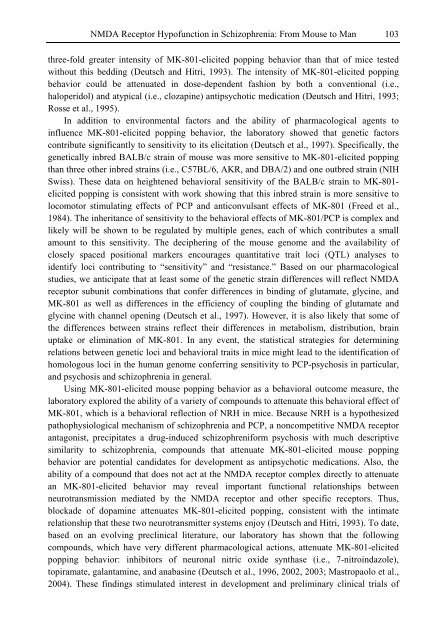Schizophrenia Research Trends
Schizophrenia Research Trends
Schizophrenia Research Trends
- No tags were found...
You also want an ePaper? Increase the reach of your titles
YUMPU automatically turns print PDFs into web optimized ePapers that Google loves.
NMDA Receptor Hypofunction in <strong>Schizophrenia</strong>: From Mouse to Man 103three-fold greater intensity of MK-801-elicited popping behavior than that of mice testedwithout this bedding (Deutsch and Hitri, 1993). The intensity of MK-801-elicited poppingbehavior could be attenuated in dose-dependent fashion by both a conventional (i.e.,haloperidol) and atypical (i.e., clozapine) antipsychotic medication (Deutsch and Hitri, 1993;Rosse et al., 1995).In addition to environmental factors and the ability of pharmacological agents toinfluence MK-801-elicited popping behavior, the laboratory showed that genetic factorscontribute significantly to sensitivity to its elicitation (Deutsch et al., 1997). Specifically, thegenetically inbred BALB/c strain of mouse was more sensitive to MK-801-elicited poppingthan three other inbred strains (i.e., C57BL/6, AKR, and DBA/2) and one outbred strain (NIHSwiss). These data on heightened behavioral sensitivity of the BALB/c strain to MK-801-elicited popping is consistent with work showing that this inbred strain is more sensitive tolocomotor stimulating effects of PCP and anticonvulsant effects of MK-801 (Freed et al.,1984). The inheritance of sensitivity to the behavioral effects of MK-801/PCP is complex andlikely will be shown to be regulated by multiple genes, each of which contributes a smallamount to this sensitivity. The deciphering of the mouse genome and the availability ofclosely spaced positional markers encourages quantitative trait loci (QTL) analyses toidentify loci contributing to “sensitivity” and “resistance.” Based on our pharmacologicalstudies, we anticipate that at least some of the genetic strain differences will reflect NMDAreceptor subunit combinations that confer differences in binding of glutamate, glycine, andMK-801 as well as differences in the efficiency of coupling the binding of glutamate andglycine with channel opening (Deutsch et al., 1997). However, it is also likely that some ofthe differences between strains reflect their differences in metabolism, distribution, brainuptake or elimination of MK-801. In any event, the statistical strategies for determiningrelations between genetic loci and behavioral traits in mice might lead to the identification ofhomologous loci in the human genome conferring sensitivity to PCP-psychosis in particular,and psychosis and schizophrenia in general.Using MK-801-elicited mouse popping behavior as a behavioral outcome measure, thelaboratory explored the ability of a variety of compounds to attenuate this behavioral effect ofMK-801, which is a behavioral reflection of NRH in mice. Because NRH is a hypothesizedpathophysiological mechanism of schizophrenia and PCP, a noncompetitive NMDA receptorantagonist, precipitates a drug-induced schizophreniform psychosis with much descriptivesimilarity to schizophrenia, compounds that attenuate MK-801-elicited mouse poppingbehavior are potential candidates for development as antipsychotic medications. Also, theability of a compound that does not act at the NMDA receptor complex directly to attenuatean MK-801-elicited behavior may reveal important functional relationships betweenneurotransmission mediated by the NMDA receptor and other specific receptors. Thus,blockade of dopamine attenuates MK-801-elicited popping, consistent with the intimaterelationship that these two neurotransmitter systems enjoy (Deutsch and Hitri, 1993). To date,based on an evolving preclinical literature, our laboratory has shown that the followingcompounds, which have very different pharmacological actions, attenuate MK-801-elicitedpopping behavior: inhibitors of neuronal nitric oxide synthase (i.e., 7-nitroindazole),topiramate, galantamine, and anabasine (Deutsch et al., 1996, 2002, 2003; Mastropaolo et al.,2004). These findings stimulated interest in development and preliminary clinical trials of
















